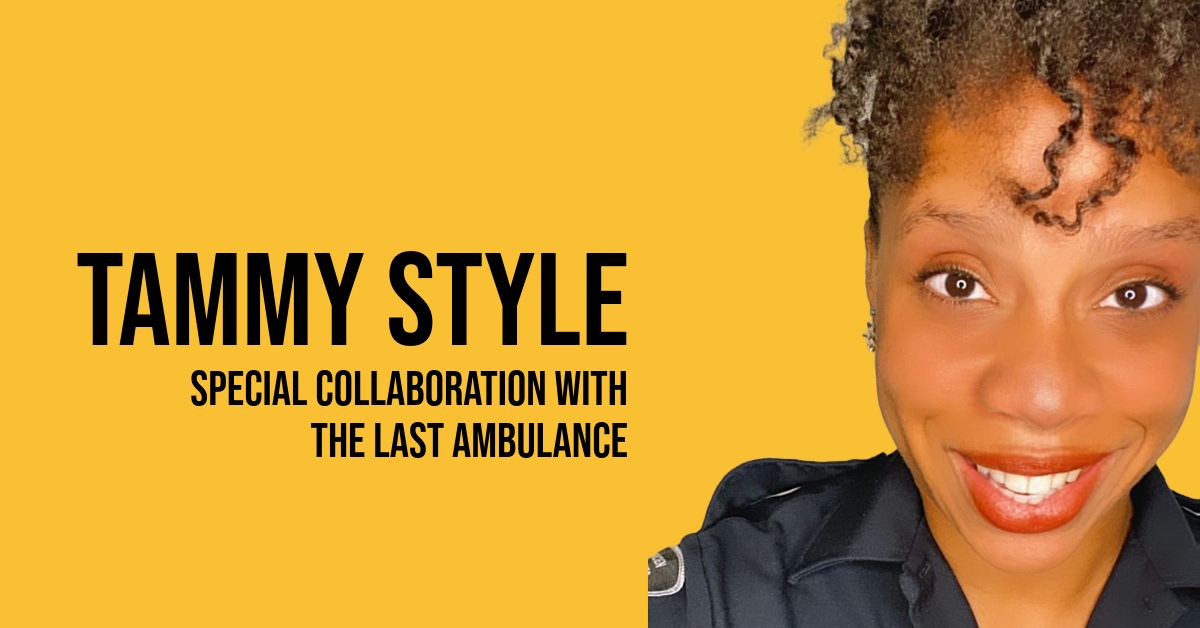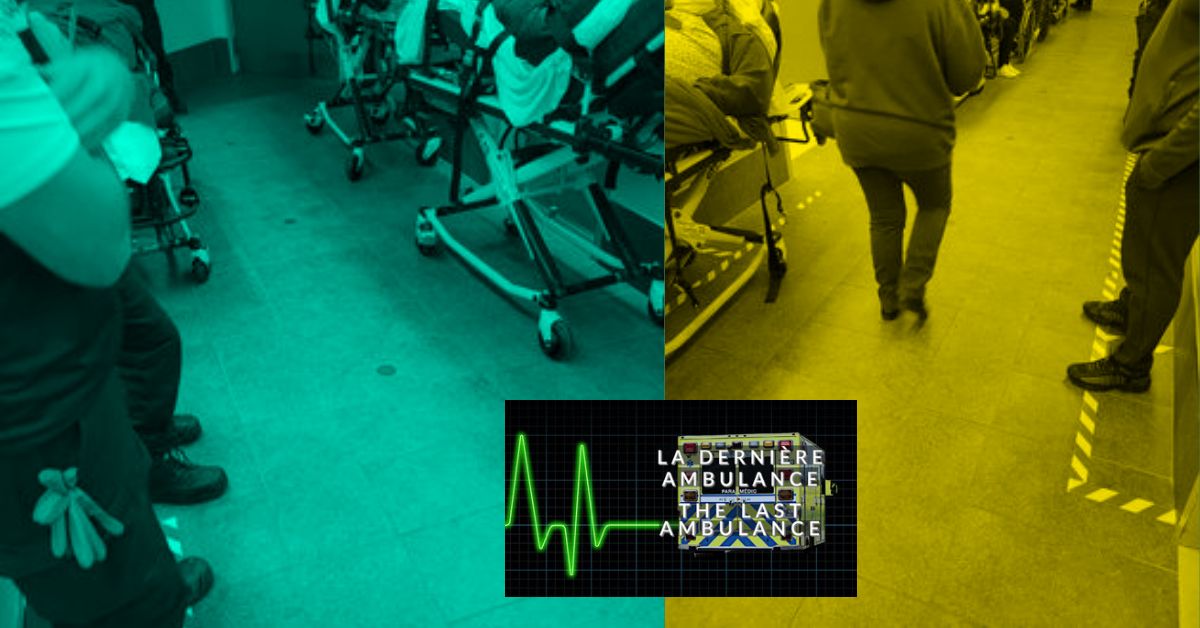Tammy Styleo : Autumn

Autumn
We've just started to see the first colors in the leaves of the trees. Even though it's unusually warm, we've definitely arrived at that time beloved by hikers, hot drinks enthusiasts, and turtlenecks.
Already!
Nostalgic, I'm standing by in my yellow vehicle, sipping a pumpkin spice latte.
We receive an emergency call for a child who has been injured in circumstances that, for now, are unexplained. There is mention of severe bleeding.
The latte will have to wait.
With sirens blaring and lights flashing lights, we rush to the home of the injured child. Upon arrival, it turns out that the injury isn't as dramatic as initially thought. There was a lot of bleeding at first – it's a significant wound which will require a few stitches. Mom and dad were quite scared but the life of our young patient is not in danger.
So, we head back to the hospital (more slowly this time).
Upon our arrival at the hospital, several ambulance crews are lined up in front of us waiting for the nurse to triage their patients. We ask our colleagues how long they've been waiting :
37 minutes.
58 minutes.
1 hour 40.
This is starting to look bad.
So, here we are, three teams in a row, six paramedics, and three patients waiting. There are even some trainees. And many people are on the other side of the curtain waiting for triage just like us.
A hospital staff member at the front cheerfully exclaims, "Welcome to the madhouse!"
This doesn't look good.
Time passes inevitably, relentlessly, and the dressing we carefully applied to the patient's wound starts to soak up his blood. Even though the wound was no longer bleeding when we arrived, the waiting has taken its toll on our compressive dressing. As mentioned, this wound will require several stitches and a lengthy recovery to regain smooth skin and full mobility.
All the necessary equipment is in the ambulance, and the mother is starting to worry. No one is paying attention to us except for the other waiting patients in the corridor. My eyes meet those of my partner: we'll have to take matters into our own hands.
This doesn't look promising.
We've been in the ER corridor for 20 minutes. We radio in to inform the dispatcher of the delay, making it clear that we won't be able to clear and respond to another emergency call if one comes in while we're stuck here, especially considering we're the only crew in the area.
The other team was already on another call when we left in a hurry.
My young partner asks me what happens to our sector when all the ambulances are tied up at the hospital, as they are now. I explain to her with a knowing look that other sectors will have to cover for us, which will leave their response zones exposed as well, setting off a chain reaction. As the ripples extend further other neighboring ambulance companies might have to get involved.
The next emergency call will undoubtedly face delays. And if another call comes in after that, there will be even more delays.
But it's still autumn, and we're still waiting.

Trying to be reassuring, another hospital staff member says, "At least while you're here, you won't bring in any more patients !"
If only Marie-Ginette knew that it doesn't work that way at all. Physical health problems, suicidal thoughts, and road accidents will keep coming, whether an ambulance is available or not.
It's only the patients' lives or, at the very least, their hopes of recovering with minimal sequelae that are affected.
But Marie-Ginette doesn't know that. She has no idea about the reality of prehospital services in Quebec, like many of her hospital colleagues.
Marie-Ginette thought she was being funny with her joke, but let's just say we didn't find it amusing.
This doesn't look promising.
The young patient asks when it will be their turn. Despite getting special permission to play on his mom's phone, he's getting hungry, thirsty, needs to use the restroom, wants to watch TV, and feels like scratching. It seems that the atmosphere in the corridor is not very entertaining.
All the things that can worry a six-year-old.
I want to reassure his mother with my usual, "It won't be long; we'll be triaged soon."
Usually, I can find a way to phrase it that doesn't sound too scary or disappointing. But not this time.
I admit the sad truth: "I wish I could tell you it won't be long, but that's probably not true, so I'll just say we're waiting."
And it's looking less and less promising.
In the meantime, the overwhelmed nurse has had to triage people who arrived on foot and are waiting to explain their problems. She's alone at triage, and it's clear they are short-staffed in the Emergency department, which is further increasing the wait times.
Finally, it's more than 57 minutes later when our turn finally comes. We change the dressing on the wound again. Our little patient is still hungry, thirsty, and anxious.
We open the medical file, hand back the IDs to the mom, and wish them a good evening. They will start their evening with an average wait time of 25 hours, according to the registration staff.
In this early autumn, as I find my (now cold) pumpkin spice latte, I wonder about this event.
How could it have gone better? Why don't paramedics have their own triage area?
Could we ease the situation by doing our own triage: transcribing our observations, patient details, and procedures ourselves? Are we capable of entering our own information, vital signs, and procedures for a patient we've been caring for sometimes more than two hours? Who knows better than us exactly what the patient has experienced and said – in what context – and at what time?
Most of the time, patients end up in the waiting area after triage. Or if some cubicle stretchers are available, depending on the situation, the nurse might be able to place the person there, waiting to see the doctor.
Why do we have to burden the nurses with transcription, recording the event word-for-word, when we are the ones who have observed, experienced... felt?
57 minutes of waiting.
Our single unit would have saved an hour without taking up space in the corridor, without disturbing the flow of admissions. I don't mean to downplay their work, but the on-site nurse could have focused on triaging walking patients. In the end, our patient would have continued waiting in the best place for their situation, without adding extra weight to the system.
But what about triage errors, you might ask?
A triage error, a misclassification, a missed detail, or just a change in the patient's condition not noticed upon arrival. A patient losing consciousness in the waiting room has already happened countless times.
And that happens regardless of who is typing into the computer – the nurse or any human qualified to do so.
That's why it's called the human factor.
A triage dedicated to paramedics : recognizing their competencies, knowledge, and the time spent with the patient, in the patient's environment, and their diverse, versatile, dynamic abilities.
We are trusted to handle a wide range of life-threatening situations. But not to transcribe a report on a hospital computer.
This doesn't look promising.
To all of you, be safe, enjoy the road trip to see the autumn colors with your family. Take care of yourselves!
-T-
*Note: The patient's identity has been changed to protect confidentiality. The rest of the details are unfortunately all authentic.
If you want to help keep The Last Ambulance in operation, please consider starting a paid subscription. Our independent journalism needs the support of this community!
Translation by GPT-3.5 with additional support from a human editor